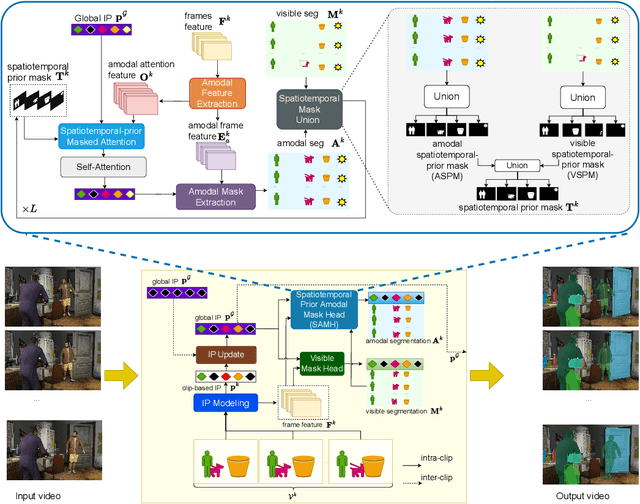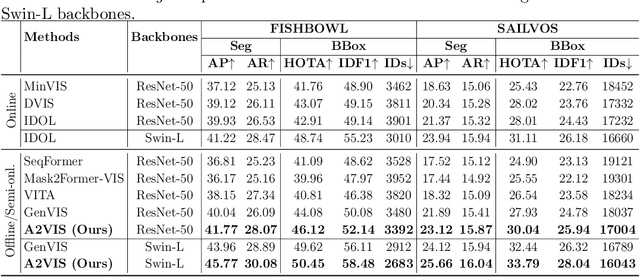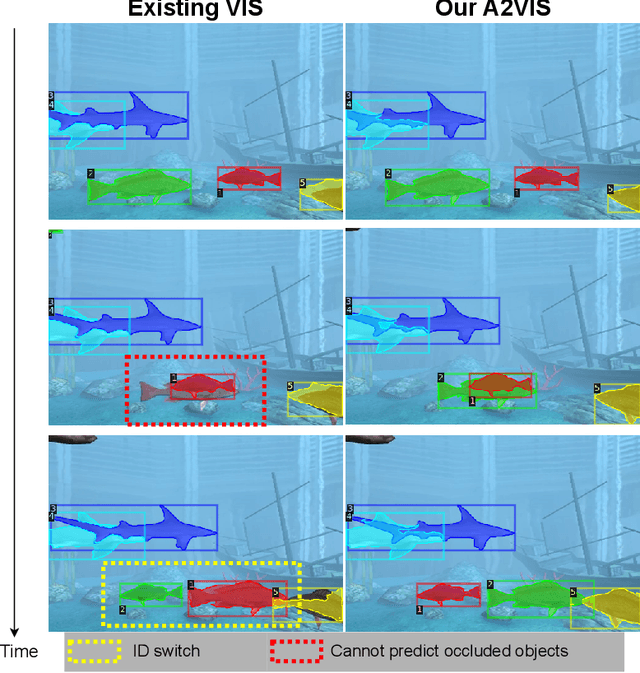Minh Tran
Discrete Facial Encoding: : A Framework for Data-driven Facial Display Discovery
Oct 02, 2025Abstract:Facial expression analysis is central to understanding human behavior, yet existing coding systems such as the Facial Action Coding System (FACS) are constrained by limited coverage and costly manual annotation. In this work, we introduce Discrete Facial Encoding (DFE), an unsupervised, data-driven alternative of compact and interpretable dictionary of facial expressions from 3D mesh sequences learned through a Residual Vector Quantized Variational Autoencoder (RVQ-VAE). Our approach first extracts identity-invariant expression features from images using a 3D Morphable Model (3DMM), effectively disentangling factors such as head pose and facial geometry. We then encode these features using an RVQ-VAE, producing a sequence of discrete tokens from a shared codebook, where each token captures a specific, reusable facial deformation pattern that contributes to the overall expression. Through extensive experiments, we demonstrate that Discrete Facial Encoding captures more precise facial behaviors than FACS and other facial encoding alternatives. We evaluate the utility of our representation across three high-level psychological tasks: stress detection, personality prediction, and depression detection. Using a simple Bag-of-Words model built on top of the learned tokens, our system consistently outperforms both FACS-based pipelines and strong image and video representation learning models such as Masked Autoencoders. Further analysis reveals that our representation covers a wider variety of facial displays, highlighting its potential as a scalable and effective alternative to FACS for psychological and affective computing applications.
Social-MAE: A Transformer-Based Multimodal Autoencoder for Face and Voice
Aug 24, 2025Abstract:Human social behaviors are inherently multimodal necessitating the development of powerful audiovisual models for their perception. In this paper, we present Social-MAE, our pre-trained audiovisual Masked Autoencoder based on an extended version of Contrastive Audio-Visual Masked Auto-Encoder (CAV-MAE), which is pre-trained on audiovisual social data. Specifically, we modify CAV-MAE to receive a larger number of frames as input and pre-train it on a large dataset of human social interaction (VoxCeleb2) in a self-supervised manner. We demonstrate the effectiveness of this model by finetuning and evaluating the model on different social and affective downstream tasks, namely, emotion recognition, laughter detection and apparent personality estimation. The model achieves state-of-the-art results on multimodal emotion recognition and laughter recognition and competitive results for apparent personality estimation, demonstrating the effectiveness of in-domain self-supervised pre-training. Code and model weight are available here https://github.com/HuBohy/SocialMAE.
* 5 pages, 3 figures, IEEE FG 2024 conference
A Robust BERT-Based Deep Learning Model for Automated Cancer Type Extraction from Unstructured Pathology Reports
Aug 21, 2025Abstract:The accurate extraction of clinical information from electronic medical records is particularly critical to clinical research but require much trained expertise and manual labor. In this study we developed a robust system for automated extraction of the specific cancer types for the purpose of supporting precision oncology research. from pathology reports using a fine-tuned RoBERTa model. This model significantly outperformed the baseline model and a Large Language Model, Mistral 7B, achieving F1_Bertscore 0.98 and overall exact match of 80.61%. This fine-tuning approach demonstrates the potential for scalability that can integrate seamlessly into the molecular tumour board process. Fine-tuning domain-specific models for precision tasks in oncology, may pave the way for more efficient and accurate clinical information extraction.
DiTaiListener: Controllable High Fidelity Listener Video Generation with Diffusion
Apr 05, 2025Abstract:Generating naturalistic and nuanced listener motions for extended interactions remains an open problem. Existing methods often rely on low-dimensional motion codes for facial behavior generation followed by photorealistic rendering, limiting both visual fidelity and expressive richness. To address these challenges, we introduce DiTaiListener, powered by a video diffusion model with multimodal conditions. Our approach first generates short segments of listener responses conditioned on the speaker's speech and facial motions with DiTaiListener-Gen. It then refines the transitional frames via DiTaiListener-Edit for a seamless transition. Specifically, DiTaiListener-Gen adapts a Diffusion Transformer (DiT) for the task of listener head portrait generation by introducing a Causal Temporal Multimodal Adapter (CTM-Adapter) to process speakers' auditory and visual cues. CTM-Adapter integrates speakers' input in a causal manner into the video generation process to ensure temporally coherent listener responses. For long-form video generation, we introduce DiTaiListener-Edit, a transition refinement video-to-video diffusion model. The model fuses video segments into smooth and continuous videos, ensuring temporal consistency in facial expressions and image quality when merging short video segments produced by DiTaiListener-Gen. Quantitatively, DiTaiListener achieves the state-of-the-art performance on benchmark datasets in both photorealism (+73.8% in FID on RealTalk) and motion representation (+6.1% in FD metric on VICO) spaces. User studies confirm the superior performance of DiTaiListener, with the model being the clear preference in terms of feedback, diversity, and smoothness, outperforming competitors by a significant margin.
Negative to Positive Co-learning with Aggressive Modality Dropout
Jan 01, 2025Abstract:This paper aims to document an effective way to improve multimodal co-learning by using aggressive modality dropout. We find that by using aggressive modality dropout we are able to reverse negative co-learning (NCL) to positive co-learning (PCL). Aggressive modality dropout can be used to "prep" a multimodal model for unimodal deployment, and dramatically increases model performance during negative co-learning, where during some experiments we saw a 20% gain in accuracy. We also benchmark our modality dropout technique against PCL to show that our modality drop out technique improves co-learning during PCL, although it does not have as much as an substantial effect as it does during NCL. Github: https://github.com/nmagal/modality_drop_for_colearning
A2VIS: Amodal-Aware Approach to Video Instance Segmentation
Dec 02, 2024



Abstract:Handling occlusion remains a significant challenge for video instance-level tasks like Multiple Object Tracking (MOT) and Video Instance Segmentation (VIS). In this paper, we propose a novel framework, Amodal-Aware Video Instance Segmentation (A2VIS), which incorporates amodal representations to achieve a reliable and comprehensive understanding of both visible and occluded parts of objects in a video. The key intuition is that awareness of amodal segmentation through spatiotemporal dimension enables a stable stream of object information. In scenarios where objects are partially or completely hidden from view, amodal segmentation offers more consistency and less dramatic changes along the temporal axis compared to visible segmentation. Hence, both amodal and visible information from all clips can be integrated into one global instance prototype. To effectively address the challenge of video amodal segmentation, we introduce the spatiotemporal-prior Amodal Mask Head, which leverages visible information intra clips while extracting amodal characteristics inter clips. Through extensive experiments and ablation studies, we show that A2VIS excels in both MOT and VIS tasks in identifying and tracking object instances with a keen understanding of their full shape.
Amodal Instance Segmentation with Diffusion Shape Prior Estimation
Sep 26, 2024Abstract:Amodal Instance Segmentation (AIS) presents an intriguing challenge, including the segmentation prediction of both visible and occluded parts of objects within images. Previous methods have often relied on shape prior information gleaned from training data to enhance amodal segmentation. However, these approaches are susceptible to overfitting and disregard object category details. Recent advancements highlight the potential of conditioned diffusion models, pretrained on extensive datasets, to generate images from latent space. Drawing inspiration from this, we propose AISDiff with a Diffusion Shape Prior Estimation (DiffSP) module. AISDiff begins with the prediction of the visible segmentation mask and object category, alongside occlusion-aware processing through the prediction of occluding masks. Subsequently, these elements are inputted into our DiffSP module to infer the shape prior of the object. DiffSP utilizes conditioned diffusion models pretrained on extensive datasets to extract rich visual features for shape prior estimation. Additionally, we introduce the Shape Prior Amodal Predictor, which utilizes attention-based feature maps from the shape prior to refine amodal segmentation. Experiments across various AIS benchmarks demonstrate the effectiveness of our AISDiff.
HENASY: Learning to Assemble Scene-Entities for Egocentric Video-Language Model
Jun 01, 2024Abstract:Video-Language Models (VLMs), pre-trained on large-scale video-caption datasets, are now standard for robust visual-language representation and downstream tasks. However, their reliance on global contrastive alignment limits their ability to capture fine-grained interactions between visual and textual elements. To address these challenges, we introduce HENASY (Hierarchical ENtities ASsemblY), a novel framework designed for egocentric video analysis that enhances the granularity of video content representations. HENASY employs a compositional approach using an enhanced slot-attention and grouping mechanisms for videos, assembling dynamic entities from video patches. It integrates a local entity encoder for dynamic modeling, a global encoder for broader contextual understanding, and an entity-aware decoder for late-stage fusion, enabling effective video scene dynamics modeling and granular-level alignment between visual entities and text. By incorporating innovative contrastive losses, HENASY significantly improves entity and activity recognition, delivering superior performance on benchmarks such as Ego4D and EpicKitchen, and setting new standards in both zero-shot and extensive video understanding tasks. Our results confirm groundbreaking capabilities of HENASY and establish it as a significant advancement in video-language multimodal research.
S3Former: Self-supervised High-resolution Transformer for Solar PV Profiling
May 07, 2024Abstract:As the impact of climate change escalates, the global necessity to transition to sustainable energy sources becomes increasingly evident. Renewable energies have emerged as a viable solution for users, with Photovoltaic energy being a favored choice for small installations due to its reliability and efficiency. Accurate mapping of PV installations is crucial for understanding the extension of its adoption and informing energy policy. To meet this need, we introduce S3Former, designed to segment solar panels from aerial imagery and provide size and location information critical for analyzing the impact of such installations on the grid. Solar panel identification is challenging due to factors such as varying weather conditions, roof characteristics, Ground Sampling Distance variations and lack of appropriate initialization weights for optimized training. To tackle these complexities, S3Former features a Masked Attention Mask Transformer incorporating a self-supervised learning pretrained backbone. Specifically, our model leverages low-level and high-level features extracted from the backbone and incorporates an instance query mechanism incorporated on the Transformer architecture to enhance the localization of solar PV installations. We introduce a self-supervised learning phase (pretext task) to improve the initialization weights on the backbone of S3Former. We evaluated S3Former using diverse datasets, demonstrate improvement state-of-the-art models.
CarcassFormer: An End-to-end Transformer-based Framework for Simultaneous Localization, Segmentation and Classification of Poultry Carcass Defect
Apr 17, 2024Abstract:In the food industry, assessing the quality of poultry carcasses during processing is a crucial step. This study proposes an effective approach for automating the assessment of carcass quality without requiring skilled labor or inspector involvement. The proposed system is based on machine learning (ML) and computer vision (CV) techniques, enabling automated defect detection and carcass quality assessment. To this end, an end-to-end framework called CarcassFormer is introduced. It is built upon a Transformer-based architecture designed to effectively extract visual representations while simultaneously detecting, segmenting, and classifying poultry carcass defects. Our proposed framework is capable of analyzing imperfections resulting from production and transport welfare issues, as well as processing plant stunner, scalder, picker, and other equipment malfunctions. To benchmark the framework, a dataset of 7,321 images was initially acquired, which contained both single and multiple carcasses per image. In this study, the performance of the CarcassFormer system is compared with other state-of-the-art (SOTA) approaches for both classification, detection, and segmentation tasks. Through extensive quantitative experiments, our framework consistently outperforms existing methods, demonstrating remarkable improvements across various evaluation metrics such as AP, AP@50, and AP@75. Furthermore, the qualitative results highlight the strengths of CarcassFormer in capturing fine details, including feathers, and accurately localizing and segmenting carcasses with high precision. To facilitate further research and collaboration, the pre-trained model and source code of CarcassFormer is available for research purposes at: \url{https://github.com/UARK-AICV/CarcassFormer}.
 Add to Chrome
Add to Chrome Add to Firefox
Add to Firefox Add to Edge
Add to Edge